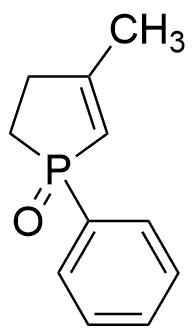3-Methyl-1-phenyl-2-phospholene 1-oxide is widely utilized in research focused on:
- Organic Synthesis: This compound serves as an important intermediate in the synthesis of various organic molecules, particularly in the development of pharmaceuticals and agrochemicals.
- Phosphorus Chemistry: It plays a crucial role in the study of phosphorus-containing compounds, which are essential in many chemical reactions and materials science applications.
- Electrophilic Reactions: This chemical is used in electrophilic reactions, providing researchers with a versatile tool for creating complex molecular structures.
- Material Science: It is employed in the development of new materials, particularly in the field of polymers, where it can enhance properties such as thermal stability and mechanical strength.
- Biological Applications: The compound is being explored for its potential in biological systems, including its use in drug design and as a probe in biochemical research.
General Information
Properties
Safety and Regulations
Applications
3-Methyl-1-phenyl-2-phospholene 1-oxide is widely utilized in research focused on:
- Organic Synthesis: This compound serves as an important intermediate in the synthesis of various organic molecules, particularly in the development of pharmaceuticals and agrochemicals.
- Phosphorus Chemistry: It plays a crucial role in the study of phosphorus-containing compounds, which are essential in many chemical reactions and materials science applications.
- Electrophilic Reactions: This chemical is used in electrophilic reactions, providing researchers with a versatile tool for creating complex molecular structures.
- Material Science: It is employed in the development of new materials, particularly in the field of polymers, where it can enhance properties such as thermal stability and mechanical strength.
- Biological Applications: The compound is being explored for its potential in biological systems, including its use in drug design and as a probe in biochemical research.
Documents
Safety Data Sheets (SDS)
The SDS provides comprehensive safety information on handling, storage, and disposal of the product.
Product Specification (PS)
The PS provides a comprehensive breakdown of the product’s properties, including chemical composition, physical state, purity, and storage requirements. It also details acceptable quality ranges and the product's intended applications.
Certificates of Analysis (COA)
Search for Certificates of Analysis (COA) by entering the products Lot Number. Lot and Batch Numbers can be found on a product’s label following the words ‘Lot’ or ‘Batch’.
*Catalog Number
*Lot Number
Certificates Of Origin (COO)
This COO confirms the country where the product was manufactured, and also details the materials and components used in it and whether it is derived from natural, synthetic, or other specific sources. This certificate may be required for customs, trade, and regulatory compliance.
*Catalog Number
*Lot Number
Safety Data Sheets (SDS)
The SDS provides comprehensive safety information on handling, storage, and disposal of the product.
DownloadProduct Specification (PS)
The PS provides a comprehensive breakdown of the product’s properties, including chemical composition, physical state, purity, and storage requirements. It also details acceptable quality ranges and the product's intended applications.
DownloadCertificates of Analysis (COA)
Search for Certificates of Analysis (COA) by entering the products Lot Number. Lot and Batch Numbers can be found on a product’s label following the words ‘Lot’ or ‘Batch’.
*Catalog Number
*Lot Number
Certificates Of Origin (COO)
This COO confirms the country where the product was manufactured, and also details the materials and components used in it and whether it is derived from natural, synthetic, or other specific sources. This certificate may be required for customs, trade, and regulatory compliance.


